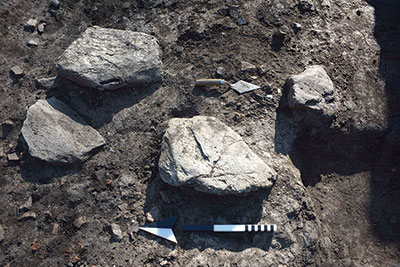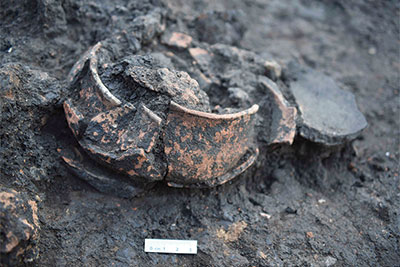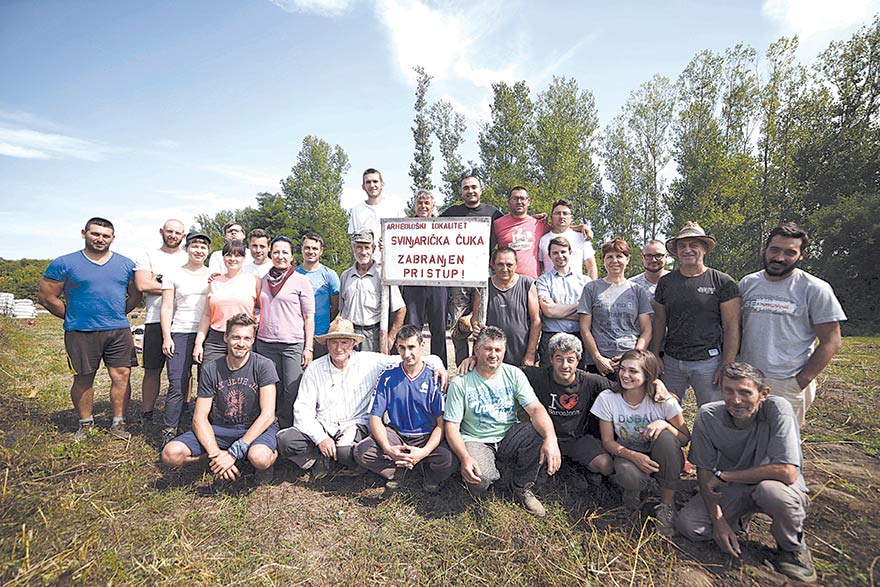An Austrian-Serbian archaeological team has proven at a site near Lebane that the Balkans represents a key-zone for understanding the past of the European continent, especially of central Europe and modern-day Austria
Last September, as part of an international research project called the Pusta Reka Project, archaeologists from Austria and Serbia began uncovering the story of European history in southern Serbia, at the Svinjarička Čuka archaeological site near the town of Lebane. The project’s partners are the Institute for Oriental and European Archaeology (OREA), the Austrian Academy of Sciences, the Belgrade Archaeological Institute and the National Museum in Leskovac. Their aim is to perform detailed analysis of the Leskovac Basin, which is believed to have been a hub a human interaction throughout various periods of the human past.
This cooperation is the reason for a series of six lectures that have been held since mid-September at the Austrian Embassy in Belgrade, in collaboration with the Austrian Academy of Sciences. The first lecture, entitled “The Beginning of History – The Balkans as a Prehistoric Bridge between Asia Minor and Europe”, was preformed by CorD’s interlocutor Professor Barbara Horejs, Director of the Institute of Oriental and European Archaeology (OREA), Austrian Academy of Sciences, and Head of Excavations at Svinjarička Čuka, and professor Sofija Stefanović of the Biosense Institute, University of Novi Sad Department of Archaeology, and the University of Belgrade Faculty of Philosophy.
The first question that arises in the mind of a layman when he hears that Austrian scientists are exploring archaeological sites in southern Serbia is – how come Central Europe is interested in prehistoric times on the territory of the Balkans. Is this way of thinking mistaken?
– The reason for our research is related with the essential developments in southeast Europe influencing central Europe in almost all steps of human history. The Balkans represents a cultural zone with a great impact on the European continent over several millennia. Analysing the crucial steps in European prehistory, such as sedentism, new economies or new technologies (e.g. metallurgy) is always linked with the Balkans, where they start first.

Understanding the complex process behind these enduring and sustainable changes requires analyses of how, why and where past societies invented, adopted or modified new ways of life. Therefore, the Balkans represents a key-zone for understanding the past of the European continent, especially of central Europe and modern-day Austria.
Exploration of the ‘Svinjarička Čuka’ archaeological site near Lebane began in 2018. What have you uncovered to date?
– Our excavations revealed the remains of several prehistoric periods on this small elevated river terrace. We found various structures from the early to mid Neolithic period (c. 6000-5600 BC), from the mid and late Bronze Age (c. 2000-1100 BC) and the early Iron Age (c. 1000-800 BC). The new site of Svinjarička Čuka shows a recurring occupation of prehistoric communities starting from around 8,000 years ago. The neighbouring famous Caričin Grad (Justiniana Prima) from the early Byzantine period (6th century AD) is therefore embedded in a cultural landscape exploited by humans for many millennia previously.ž
What proved that the discovery was a prehistoric settlement; how did people live there?
– Prehistoric archaeology represents a field of research strongly linked with a bundle of other (natural and life) sciences, such as genetics, anthropology, botany, zoology, geography, chemistry, mineralogy, climatology etc. All kinds of excavated remains are analysed by an interdisciplinary team of experts to provide detailed information. For example, the remains of carbonised crops (emmer, wheat) have been dated with the radiocarbon method (C14), which is scientifically proven to give us exact dates for archaeological remains. We therefore know that the lowest levels we could excavate so far are 7,600 years old. Further cultural layers of 0.80m underneath are attested by core drillings and are expected to go back to 6200 to 6000 BC (radiocarbondating of the core charcoals).
The first settlers at the site practised agriculture by means of farming and herding domesticated animals. Our data demonstrates the field farming of wheat, emmer, einkorn and pulses.
Bridging diverse cultural regions, instead of closing long-established communication routes between the Balkans and central Europe, would be another lesson to learn from the past
The nutrition of this early Neolithic community, with domesticated sheep, goats, pigs and cattle, was complemented with the hunting of wild species like red deer, wild boar, roe deer, ibex, badger and fox.
These Neolithic farmers, herders and hunters produced their own textiles (attested to by production implements), jewellery (beads) and all kinds of household work. The community of the Svinjarička River terrace was very experienced in the management of available resources, of which workable stones and minerals are of special importance in the Neolithic (Stone Age) period.
The accessibility of good-quality sources of cherts (flint-stone) in the direct vicinity of the site might be one reason for the first pioneers occupying this region around 8,000 years ago.
Another important aspect is represented in the fruitful environment, which presumably offered a suitable landscape for early agriculture under appropriate conditions. Both elements – sources or raw materials and environmental conditions – are key to understanding the movements of people to new lands.
How people communicated and spread the Neolithic culture back then is among the questions that the research at ‘Svinjarička Čuka’ is expected to answer.
– Our research project, funded by the Austrian Science Fund (FWF) and the Austrian Academy of Sciences, is dedicated to uncovering the spreading of the Neolithic way of life to the European continent. The current facts and data of world archaeology demonstrate that, to date, the oldest farmers and herders in Europe are attested on the Greek mainland and on the Balkans. All other routes of the Neolithic dispersal from the Near East via the central and western Mediterranean are slightly later and not related directly to the establishment of the first sedentary communities in central Europe. The Balkans plays a key role in understanding how, when and why the transformation from mobile hunter-gatherers into farmers and herders living in permanent villages took place.

Many basic elements of the new Neolithic life are long-lasting and have impacted on the globe (and climate) to this day, such as the dependency of modern societies on industrial agriculture, ongoing tendencies to urbanise or source management strategies.
Most Neolithic innovations spread side-by-side into other world regions, where mobile hunter-gatherers are partially evident. This so-called “Neolithic package” most probably came with groups of people seeking new land. Our research hypothesis of small-scale migrations from Anatolia and the Aegean regions into the Balkans is based on a bundle of facts and data:
Particular new technologies, such as ceramic-vessel production or distinct modes to produce stone tools (socalled pressure technology), are discussed as being linked with the dispersal of the first Neolithic farmers. The farming of cultivated crops and herd management are essential new skills embedded in a broad package of knowledge.

Not least, the cultivated and domesticated new species are related to humans and would hardly have moved by themselves. Recent aDNA studies support the migration model in both the relations of human and animal DNA of the Balkans with their ancestors in the Near East and Anatolia.
The link between mobile hunter-gatherers, first farming communities and their neighbouring regions are of particular interest in our research project, in order to analyse the process of migration, innovation, adoption and adaptation.
In mid-September, a series of six lectures on the Balkans as a bridge between Asia Minor and Europe began at the Austrian Embassy, with the objective of showing that interconnectivity between people from that part of the world has existed since prehistoric times. What should we learn from their example? – From my perspective as a scientist, I would rather stress the general phenomena and process related with the attested connectivity between the Near East, Anatolia, the Balkans and the inner European continent, instead of highlighting single events.
The communication between mobile hunter-gatherers, first farming communities and their neighbouring regions are of particular interest in our research project, in order to analyse the process of migration, innovation, adoption and adaptation
Generally speaking, most of the essential developments in human history started in the Near East and Anatolia, some also in the Balkans, which plays a crucial role in inventing and transmitting the main steps of humankind into Europe. Migrations of people formed a crucial part in the spread of new civilisations over millennia, of which central Europe mostly received innovations, technologies, knowledge and skills. The connectivity of communities living in different ecological and economic zones formed the framework of a dynamic and fruitful intellectual environment, where new ideas, concepts and adaptation processes took place. Connected groups and communities were establishing stable communication networks lasting hundreds or even thousands of years only within a favourable environment.
Creating such stable environments to enable the positive dynamic of connectivity would be one aspect that our modernday society could learn from the past. Border-crossing networks were successful over millennia by means of developing new technological, social and cultural practises to face past challenges (such as climate change). Bridging diverse cultural regions, instead of closing long-established communication routes between the Balkans and central Europe, would be another lesson to learn from the past.
The ‘Svinjarička Čuka’ site has brought together scientists from Austria, Germany and Serbia. In your opinion, is cooperation among European archaeologists at an enviable level in terms of quantity?
– As the history of science in the 19th and 20th centuries demonstrates convincingly, successful research is always international and not limited to distinct nationalities or even continents. The high degree of specialisation in distinct research fields nowadays requires international collaboration, which is additionally requested by our scientific community’s regularities and the international competition in excellent research programmes.

When we initiated collaboration between the OREA institute of the Austrian Academy of Sciences and Serbian partners at universities, museums and research institutions in 2017, I was surprised that we were the first Austrian-Serbian mission in archaeology so far. The same can be stated for our collaborations with North Macedonia or Bosnia-Herzegovina. We confronted this lack of collaboration among Austrian scientists and partners from the Balkans by developing a “Balkan Archaeology” focus in our research programme at the OREA institute, in order to initiate new projects, support young scholars from various countries of Southeast Europe and establish new and broad collaborations. Our Balkan Archaeology programme is quite successful, which is already visible in the new scientific networks and project outcomes of the last few years (books, exhibitions, scholarships etc.).
Exploration of the site near Lebane is planned to last for several years. What other discoveries are expected?
– We hope to find further and large undisturbed cultural layers with the remains of early farmers dating back to the pioneering phase of the first settlers, around 8,000 years ago. So far we’ve only been able to identify their traces in small areas, which did not include constructed dwellings.
The lack of solid built architecture in the early phases of the Neolithic period in the central Balkans is astonishing and requires further scientific analyses. Our future excavations are expected to show whether we are in fact lacking remains of housing structures (or even the clustering of dwellings into a village system) or if archaeological data can provide other explanations for this gap. We additionally hope for good archaeological contexts to analyse past climatic conditions, the practises of farming, herding and hunting, the management of resources and exchanges of raw materials.
Artefacts and objects embedded in good contexts would offer the chance to analyse innovations and technologies in various aspects; the latter is expected to shed new light on the cultural process of adoption and modification, as important factors in the spreading of innovations. Nevertheless, we will only know after removing the earth and soils, and I hope that our Austrian-Serbian mission will be lucky in future campaigns.